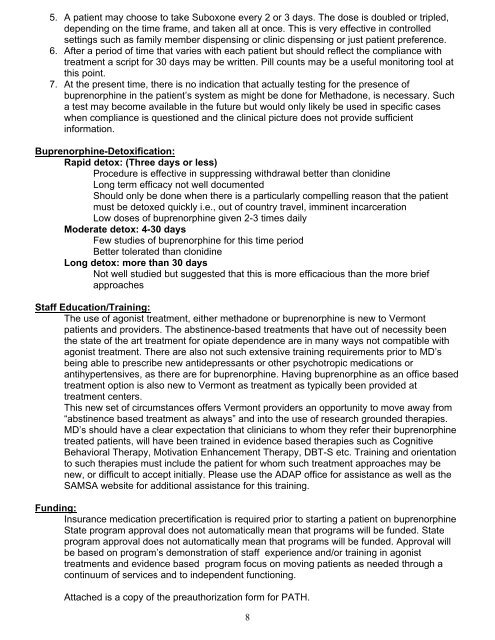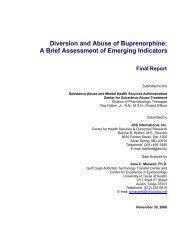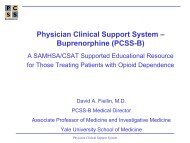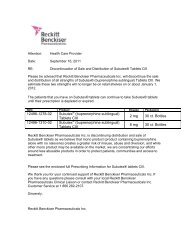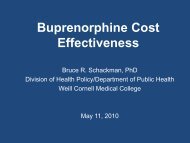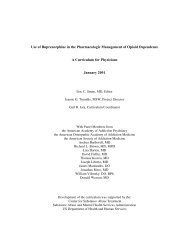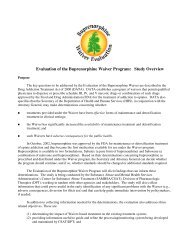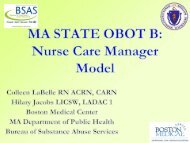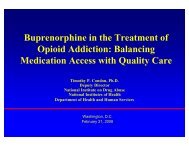Diversion and Abuse of Buprenorphine: A Brief Assessment of ...
Diversion and Abuse of Buprenorphine: A Brief Assessment of ...
Diversion and Abuse of Buprenorphine: A Brief Assessment of ...
You also want an ePaper? Increase the reach of your titles
YUMPU automatically turns print PDFs into web optimized ePapers that Google loves.
5. A patient may choose to take Suboxone every 2 or 3 days. The dose is doubled or tripled,<br />
depending on the time frame, <strong>and</strong> taken all at once. This is very effective in controlled<br />
settings such as family member dispensing or clinic dispensing or just patient preference.<br />
6. After a period <strong>of</strong> time that varies with each patient but should reflect the compliance with<br />
treatment a script for 30 days may be written. Pill counts may be a useful monitoring tool at<br />
this point.<br />
7. At the present time, there is no indication that actually testing for the presence <strong>of</strong><br />
buprenorphine in the patient’s system as might be done for Methadone, is necessary. Such<br />
a test may become available in the future but would only likely be used in specific cases<br />
when compliance is questioned <strong>and</strong> the clinical picture does not provide sufficient<br />
information.<br />
<strong>Buprenorphine</strong>-Detoxification:<br />
Rapid detox: (Three days or less)<br />
Procedure is effective in suppressing withdrawal better than clonidine<br />
Long term efficacy not well documented<br />
Should only be done when there is a particularly compelling reason that the patient<br />
must be detoxed quickly i.e., out <strong>of</strong> country travel, imminent incarceration<br />
Low doses <strong>of</strong> buprenorphine given 2-3 times daily<br />
Moderate detox: 4-30 days<br />
Few studies <strong>of</strong> buprenorphine for this time period<br />
Better tolerated than clonidine<br />
Long detox: more than 30 days<br />
Not well studied but suggested that this is more efficacious than the more brief<br />
approaches<br />
Staff Education/Training:<br />
The use <strong>of</strong> agonist treatment, either methadone or buprenorphine is new to Vermont<br />
patients <strong>and</strong> providers. The abstinence-based treatments that have out <strong>of</strong> necessity been<br />
the state <strong>of</strong> the art treatment for opiate dependence are in many ways not compatible with<br />
agonist treatment. There are also not such extensive training requirements prior to MD’s<br />
being able to prescribe new antidepressants or other psychotropic medications or<br />
antihypertensives, as there are for buprenorphine. Having buprenorphine as an <strong>of</strong>fice based<br />
treatment option is also new to Vermont as treatment as typically been provided at<br />
treatment centers.<br />
This new set <strong>of</strong> circumstances <strong>of</strong>fers Vermont providers an opportunity to move away from<br />
“abstinence based treatment as always” <strong>and</strong> into the use <strong>of</strong> research grounded therapies.<br />
MD’s should have a clear expectation that clinicians to whom they refer their buprenorphine<br />
treated patients, will have been trained in evidence based therapies such as Cognitive<br />
Behavioral Therapy, Motivation Enhancement Therapy, DBT-S etc. Training <strong>and</strong> orientation<br />
to such therapies must include the patient for whom such treatment approaches may be<br />
new, or difficult to accept initially. Please use the ADAP <strong>of</strong>fice for assistance as well as the<br />
SAMSA website for additional assistance for this training.<br />
Funding:<br />
Insurance medication precertification is required prior to starting a patient on buprenorphine<br />
State program approval does not automatically mean that programs will be funded. State<br />
program approval does not automatically mean that programs will be funded. Approval will<br />
be based on program’s demonstration <strong>of</strong> staff experience <strong>and</strong>/or training in agonist<br />
treatments <strong>and</strong> evidence based program focus on moving patients as needed through a<br />
continuum <strong>of</strong> services <strong>and</strong> to independent functioning.<br />
Attached is a copy <strong>of</strong> the preauthorization form for PATH.<br />
8


